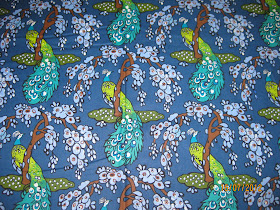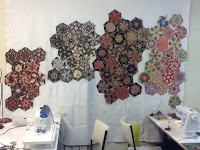A beautiful sunny day in Levin - Japanese meshwork class held at Krazy Cow today. So exciting to see the blocks taking shape.
Saturday, 28 July 2012
Japanese Meshwork - Krazy Cow
A beautiful sunny day in Levin - Japanese meshwork class held at Krazy Cow today. So exciting to see the blocks taking shape.
Saturday, 21 July 2012
Kaleidoscope Class at Sawmillers
Sunday, 15 July 2012
Rainey Sunday Doodle
Saturday, 14 July 2012
Japanese Meshwork - quilt as you go
This is a note for my Meshwork students who have completed the basics in meshwork and are now proceeding onto more intricate weaves from the Meshwork Books. The best way to join your meshwork blocks together or into a quilt is to use the "quilt as you go" method.
Cut front strip 1 1/8" and back strip 1 3/4". Iron the back strip in half.

Place the front strip onto the right side edge of your block with the back strip at the back.
Sew a 1/4" seam.
Then sew the other side of the front strip onto the right side of your next block.

Once the two blocks are joined by the front strip, turn your blocks over, pin the back folded edge onto the second block butting the two edges together. Hand stitch down.

Cut front strip 1 1/8" and back strip 1 3/4". Iron the back strip in half.

Place the front strip onto the right side edge of your block with the back strip at the back.
Sew a 1/4" seam.
Then sew the other side of the front strip onto the right side of your next block.

Once the two blocks are joined by the front strip, turn your blocks over, pin the back folded edge onto the second block butting the two edges together. Hand stitch down.
Meshwork & kaleidoscope class blocks
Meshwork and Kaleidoscope blocks under construction by students at Cherry Pie.
Another exciting Kaleidoscope class today, Interesting to see two students using the same fabric and to see their blocks turning out quite different. Will follow these pictures up in a month when all the blocks have been constructed and the quilt tops are to be designed.

Another exciting Kaleidoscope class today, Interesting to see two students using the same fabric and to see their blocks turning out quite different. Will follow these pictures up in a month when all the blocks have been constructed and the quilt tops are to be designed.
Thursday, 12 July 2012
Shibori Kimono
I have just finished this wall hanging quilt that has taken me over a year to make. Although the idea is original I have included Japanese Meshwork and blocks from Susan Briscoe's "Japanese Taupe quilt blocks" book.
I found & bought this Shibori Kimono in Asia Gallery, Kilbirnie (NZ). Its made from cotton and hand dyed using the traditional Japanese Shibori technique. Had I taken it outside I would have seen the yellow staining all down the back and under the arms in the front of the Kimono. I was unable to remove the staining but all was not lost as plans and ideas can be changed.


It was amazing to find so much fabric within its seams as I unpicked it. I have used the front body and the back of the sleeves. Undamaged fabric has been included into other blocks around the kimono. I created the Obe using dress fabric.
Techniques used are hand applique, hand and machine piecing, meshwork (Japanese weaving), machine quilting and has been put together using the "quilt as you go techique".
This quilt came about as part of my bookshelf challenge where I use techniques or ideas from my books and incorporate them into a quilt.
Monday, 2 July 2012
Japanese Meshwork Books
For those of you who have attended my meshwork classes and wish to explore this technique further these books are now available from Minerva (NZ Quilter).
Definately a must for your bookshelf. They are in Japanese, however the pictures are clear enough to follow.
 First book has now been reprinted.
First book has now been reprinted.
minerva.co.nz/Store/ProductDetails.aspx?product=9603...119
 NEW - the designs in this book will blow you away.
NEW - the designs in this book will blow you away.
minerva.co.nz/Store/ProductDetails.aspx?product=9604...119
The best tools for this techinque are made by clover (Japanese). Bodkins are smaller for the finer weaves, applique pins do not hurt your fingers and the 5mm fusable tape fits nicely into the 9mm (purple) bias tool.
A word of caution regarding the circular stack and slash image on page 40 (new book) its instructions on page 87. With the expense and time required to make each panel you need to take care with the cut edges. I notice that the instructions indicate using a zig zag stitch or heringbone stitch. Whatever effect you decide to use, give your piece a really good iron (dry heat - no steam). If you intend to use a bias to cover your joins, make sure the bias is cut on the bias not the straight of grain like those you use for weaving. Why not experiment with the fancy embroidary stitches on your sewing machine.
Happy meshing

Definately a must for your bookshelf. They are in Japanese, however the pictures are clear enough to follow.
minerva.co.nz/Store/ProductDetails.aspx?product=9603...119
minerva.co.nz/Store/ProductDetails.aspx?product=9604...119
The best tools for this techinque are made by clover (Japanese). Bodkins are smaller for the finer weaves, applique pins do not hurt your fingers and the 5mm fusable tape fits nicely into the 9mm (purple) bias tool.
A word of caution regarding the circular stack and slash image on page 40 (new book) its instructions on page 87. With the expense and time required to make each panel you need to take care with the cut edges. I notice that the instructions indicate using a zig zag stitch or heringbone stitch. Whatever effect you decide to use, give your piece a really good iron (dry heat - no steam). If you intend to use a bias to cover your joins, make sure the bias is cut on the bias not the straight of grain like those you use for weaving. Why not experiment with the fancy embroidary stitches on your sewing machine.
Happy meshing









.JPG)
.JPG)







